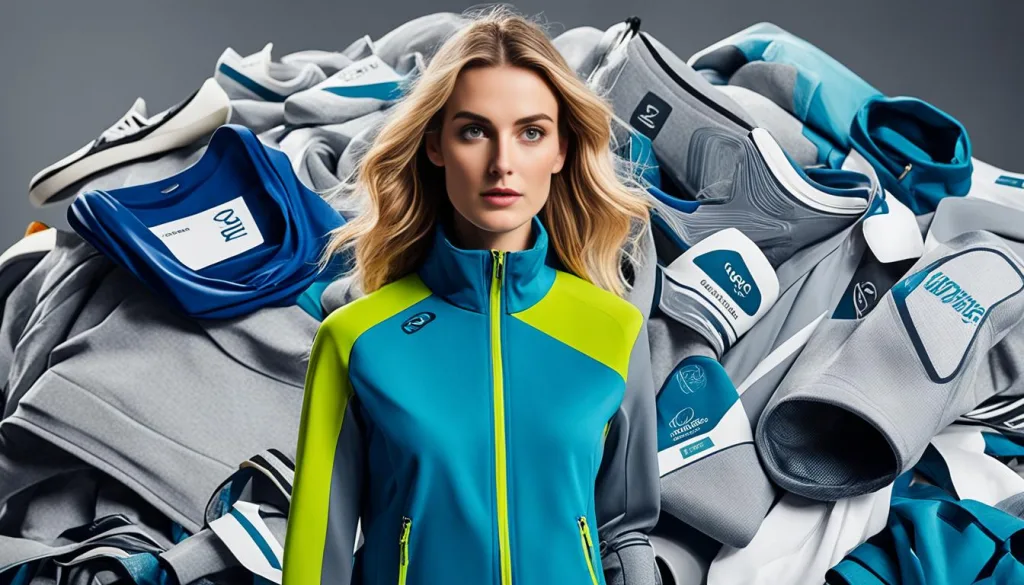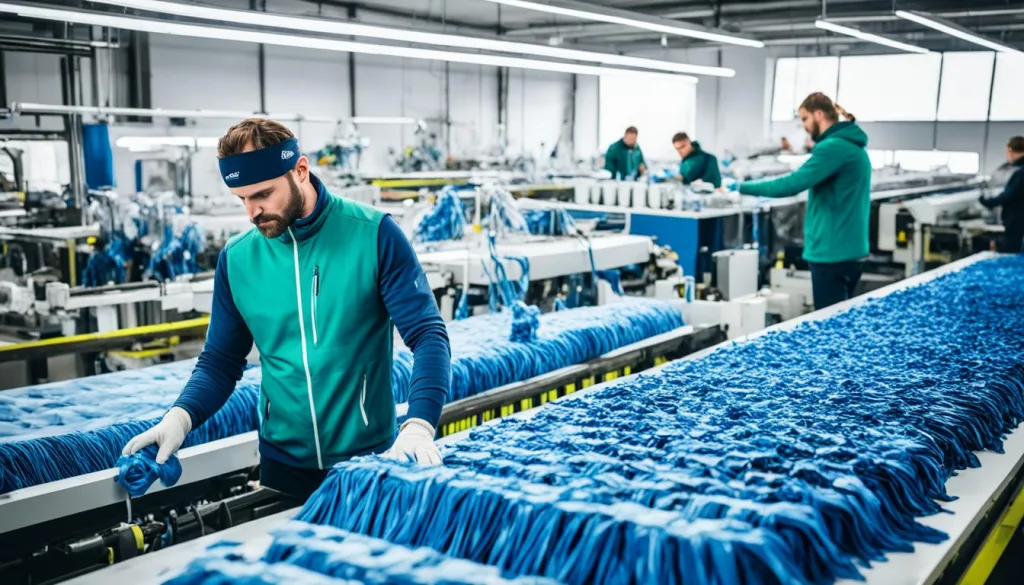Global Market Responses to Recycled and Upcycled Sportswear
Connect With Us Today
Consider us for your next production run. Why wait? Send us your questions here.
The rise of conscious consumerism is leading to a positive change in the global market. Recycled and upcycled sportswear are marking the start of a new sustainable era in fashion. The trade market for global secondhand clothing was worth $5 billion in 20211.
Customers now prefer eco-friendly options that follow the reduce, reuse, and recycle mantra. This change is pushed by both eco-conscious buyers and innovative brands. They are using cutting-edge recycled materials and upcycling methods. This is helping the sportswear sector grow more ethical.
Key Takeaways
- The surge in global market responses to sustainable initiatives in sportswear is shaping industry trends.
- With a substantial market valuation, recycled and upcycled apparel are becoming mainstream consumer choices1.
- Charities face challenges in selling donated items, identifying the need for innovative recycling methods1.
- Technological advancements are critical for upscaling recycling processes to reduce fashion waste emissions2.
- Biodegradable materials like Zeology leather are garnering industry attention for their environmental benefits2.
- Pioneering projects in sportswear recycling are showing potential pathways for sustainability in fashion2.
Sustainable Fashion’s Rise: Eco-Friendly Activewear Trends and Consumer Demand
Sustainable fashion is changing what people want to buy, with a big focus on green activewear. This change is about more than just style. It shows a deep care for the environment and choosing clothes that are kind to our planet.
Driving Forces Behind the Boom in Sustainable Sportswear
People are now choosing sportswear that’s good for the planet. This is because many want to lessen the effects of climate change. In a survey, two-thirds think this is very important3. Also, 88% of people say we need to cut down on pollution. This points to a strong market for green sportswear3.
The clothing industry is known for CO2 emissions. But now, there’s a chance to change our shopping habits. This could really help the environment4.
Consumer Purchasing Behaviors and Preferences for Green Apparel
Recent studies show a shift towards sustainable materials. For 67% of shoppers, this is key when buying3. A brand’s green commitment also matters to 63% of customers3.
People stick to brands they know and trust, with 70% staying loyal. And 75% value a brand they can trust. This ties loyalty and eco-awareness together in a shaky economy3.
Statistical Data on Eco-conscious Choices in Athletic Wear
When it comes to athletic wear, the numbers tell a story. Around 57% of people are making eco-friendly choices in their lives3. And 60% look for products with green packaging3.
Many, about 65%, plan to buy items that last longer. This shift towards quality over quantity is growing3. Also, 71% want to keep their clothes longer, showing a move towards a more sustainable wardrobe3.
| Eco-Friendly Sportswear Trends | Consumer Demand (% of Respondents) | Behavioral Changes |
|---|---|---|
| Durability and Longevity of Apparel | 65%3 | Planning to purchase more durable items |
| Secondhand Fashion Items | 50%3 | Expect to purchase more post-COVID-19 |
| Trusted Eco-friendly Brands | 70%3 | Sticking with known and trusted during crisis |
| Use of Sustainable Materials | 67%3 | Important purchasing factor |
Technological Advancements in Sportswear Upcycling and Recycling
Modern technology has brought big changes to eco-friendly fashion, especially in sports. Sportswear upcycling and sportswear recycling are key for a greener future in sustainable sportswear manufacturing.

Innovative Processes Enhancing Sustainable Sportswear Manufacturing
Technology has made it easier to reuse and refill, instead of using things once. This helps use less new plastic5. Finding new ways to recycle and creating new materials are vital for dealing with plastics that aren’t recycled yet5.
We all agree more people should recycle. To do this, we need better ways to collect and sort recyclables, and get everyone involved5.
Key Companies Revolutionizing Recycled Materials in Athletic Wear
Nike aims to hit big eco goals by 2025, focusing on reducing carbon, waste, water use, and harmful chemicals6. They’re working on reusing materials and creating new ones to stop waste and reduce carbon emissions. This shows their strong commitment to recycling6.
They also collect old and unused products to make new ones, featuring the recycled “Sunburst” logo. This is how they put their circular ideas into action6.
Global Market Responses to Recycled and Upcycled Sportswear
The world is paying more attention to recycled and upcycled sportswear. Big brands are innovating, but we need to work harder on using different materials, designing better products, and improving recycling systems5. Also, faster progress in technology through partnerships is important5.
Investing in this area is tricky because of different rules everywhere. This makes it hard for the industry to work together5.
| Company | Sustainability Targets | Recycling Initiatives |
|---|---|---|
| Nike | Zero carbon & zero waste by 2025 | Circular design, Material reuse, Product care guides |
| Initiatives | Community Engagement | Marketplace Innovation |
| Recycling Programs | Shoe and apparel recycling | Reselling gently used shoes |
The Environmental Impact of Sportswear Production and the Path to a Circular Economy
The fashion world is nearing a sustainable makeover. Sportswear production is getting a lot of attention for its ecological footprint. Adopting a circular economy is key to fighting climate change and using resources wisely.
Sportswear production uses a lot of water, energy, and chemicals. These methods can harm ecosystems and increase pollution. Something needs to change in the sustainable fashion industry.

Moving to a circular economy means we have to think differently. We need to design and make products to be reused, not thrown away. This supports sustainable fashion industry goals. Using less and recycling more can lower the environmental impact of sportswear.
Let’s look at how traditional and circular methods differ:
| Traditional Production | Circular Production |
|---|---|
| Linear ‘take-make-dispose’ model | Regenerative by design |
| High water and energy consumption | Use of renewable energy and recycled water |
| Textile waste in landfills | Textile recycling and material innovation |
| Chemical-heavy dyes and finishes | Eco-friendly dyes and biodegradable materials |
Embracing a circular economy brings many benefits to sustainable fashion. It helps save resources, promotes recycling, and supports eco-friendly jobs. This shift is good for business, the environment, and society.
Moving towards sustainability in sportswear production is crucial. It’s a movement, not just a mere trend. Embracing circular economy practices shows that the sustainable fashion industry is ready for a change. It’s about creating a better future for fashion.
Assessment of the Green Sports Apparel Market: Analysis and Projections
The green sports apparel market is growing fast. This is because more people want sustainable clothes and the fashion industry needs to change. Studies show a big rise in people choosing eco-friendly sports brands. This change is pushed by new rules and companies wanting to do good. Everyone is seeing how important it is to reduce fashion’s harm to the environment.
The world of fashion is set to grow from $1.5 trillion in 2020 to $2.25 trillion by 20257. Using eco-friendly materials and making clothes ethically is now crucial. This growth is helped by more people caring about the planet. It’s also because of new brands that focus on being eco-friendly. They are finding new ways to take a bigger share of the market.
Market Share, Growth, and Trend Analysis of Sustainable Sportswear Brands
The green sports clothing market is getting bigger thanks to eco-friendly brands. These brands are taking customers from fast fashion giants because people prefer greener choices7. Analysis shows that we make twice as many clothes as we did back in 2000, creating over 150 billion pieces a year. But we only recycle 15% of our clothes. This shows big chances for growth in eco-friendly fashion7.
Policies Influencing the Rise of Eco-Friendly Sports Apparel
Rules and policies are key in making sports clothes more eco-friendly. The EU throws away 2 million tons of textiles each year. This huge waste shows why we need policies to make a change7. Laws about waste, taxes, and trade are pushing companies to be greener.
The Role of Corporate Social Responsibility in Fashion Sustainability
Companies are now making their operations more mindful of the environment. The fast fashion industry makes a huge amount of waste. It also forms almost 2% of the world’s GDP because of its high sales7. In the US, we see 17 million metric tons of textile waste each year. This presents a big chance for the fashion world to become more sustainable7.
Sustainable sportswear is becoming more appealing because of company policies. These policies match growth with caring for the planet. In this way, the green sports apparel market is changing how sustainability is seen in fashion. And it’s influencing the choices we make for a better future.
An intensive studyThis study shows how an industry can change for the better7. Policies and good corporate actions can make fashion more sustainable. This change can greatly reduce waste. And it can make sportswear better for both people and the planet.
Conclusion
Now, more than ever, the sportswear industry is changing for the better. Thanks to a focus on environmental care and sustainability. People love eco-friendly sportswear, as shown by global market responses. Each person in Europe throws away more than 15 kilograms of clothes, but very little gets recycled8. Yet, there’s hope! By 2030, recycling could take care of up to 26% of textile waste8. This would be a big win for the planet and could create 15,000 jobs.
To really make a difference, we need better recycling technology and more money invested, around €6 billion to €7 billion8. This could lead to big benefits, including making €1.5 billion to €2.2 billion in profits by 20308. By improving recycling, Europe can tackle its waste problem. This involves getting more people to recycle and making the system better8.
Making sportswear sustainable is a team effort. It includes everyone from customers to companies, all working together. It’s about being kind to our planet and making smart business moves. This isn’t just a passing phase. It’s about taking real steps toward a cleaner, greener future.
FAQ
What are the global market responses to recycled and upcycled sportswear?
What are the driving forces behind the boom in sustainable sportswear?
What are consumer purchasing behaviors and preferences for green apparel?
Is there any statistical data on eco-conscious choices in athletic wear?
What are the technological advancements in sportswear upcycling and recycling?
Which key companies are revolutionizing the use of recycled materials in athletic wear?
How is the global market responding to recycled and upcycled sportswear?
What is the environmental impact of sportswear production, and how can it be addressed?
What is the green sports apparel market’s assessment, and what are the projections?
What is the role of corporate social responsibility in promoting fashion sustainability?
Source Links
- https://www.cnn.com/2023/08/10/africa/kantamanto-textile-market-ghana-or-foundation-spc-intl/index.html
- https://www.forbes.com/sites/brookerobertsislam/2023/12/21/mass-recycling-of-fashion-is-years-away-is-composting-an-alternative/
- https://www.mckinsey.com/industries/retail/our-insights/survey-consumer-sentiment-on-sustainability-in-fashion
- https://www.mdpi.com/2071-1050/12/7/2788
- https://www.energy.gov/eere/bioenergy/articles/transitioning-sustainable-circular-economy-plastics-workshop-report-2023
- https://www.nike.com/sustainability
- https://www.ncbi.nlm.nih.gov/pmc/articles/PMC9983045/
- https://www.mckinsey.com/industries/retail/our-insights/scaling-textile-recycling-in-europe-turning-waste-into-value
Latest News
How Collaboration Shapes Consumer Preferences in Sportswear
Navigating Consumer Rights and Warranties in Sportswear Sales
Artificial Intelligence in Fashion Forecasting and Trend Analysis
The Shift Towards Inclusive Sizing in Sportswear: Consumer Reactions
The Global Expansion of Luxury Sportswear Brands
From Sketch to Gym: The Design Process of Fashionable Sportswear
Understanding the Role of Trade Associations in Sportswear Compliance
How Economic Trends Influence Consumer Spending on Sportswear
Learning from Successful Global Market Entries
Best Practices for Managing Cross-Cultural Teams
Using Technology to Fight Counterfeit Fashion Products
Carbon Nanotube Fabrics for Superior Strength and Flexibility
The Growth of Fitness Tracking Apparel in Health and Wellness
Exploring the Influence of Social Proof in Sportswear Purchasing
Strategies for Managing Compliance in a Multinational Operation
Trends in Global Footwear: Performance Meets Lifestyle
The Role of Artificial Intelligence in Tracking Supply Chain Operations
Evaluating the Success of Sportswear Collaborative Projects
Evaluating the Potential of Emerging Markets
Global Shifts Towards Gender-Neutral Sportswear
Share This Article
Latest Articles



















